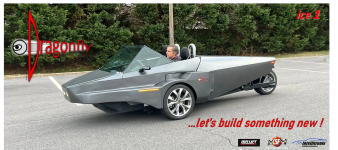I have read many threads here and in other forums about people trying to convert a car that originally had an ice into an electric vehicle. Has anyone tried to design a vehicle from the ground up to be an electric vehicle? I am looking for ideas and threads that can be accomplised by mortal man - not requiring $billions. What I hope to find is a 2 seater, 3 wheeled (tadpole) that has a lot of storage in the rear - a 3 wheeled pickup, if you will. Bonus points awarded if it has all wheel drive, even if the 3 wheel is only used at low speed. Must have a safe cruising speed of 60 mph. Maybe...by the time these requirements are satisfied, it would have been cheaper to convert a small 4x4 jeep? or an older awd Subaru?
Not sure if you've ever looked around the roads, but there are plenty of EVs that were designed *as* EVs, sold commercially, so there have most definitely been some. If none of them fit your specific needs or conditions, you could probably at least take info, parts, design ideas, etc. from them.
There is a website I can't recall the name of that is a "library" of assorted EV builds; most are conversions but there have been some scratch builds on there.
DIY Electric Car Forums may have some, most of the ones on the above site were probably started on this one.
The actual primary vehicle design will not depend on power source, but instead will depend on your specific usage, conditions, etc, so you would not want to restrict your research to EVs.
For three wheelers...others have pointed out various disadvantages of them, but it depends on your specific design and intent, so you'll have to look at the reasons for the disadvantages, compare them to your specific list of needs and functionality requirements, and see if they apply to your design ideas. If all you need is totally straight line high speeds it's not such a big deal, but if you need to maneuver at those speeds, your design is going to have to be built like any other similar threewheeler that can safely do whatever you need it to do, or you'll have to come up with a new design that does.
The big problem with something that's a three wheeler truck is it's going to almsot certainly have to have two wheels in the rear to handle the load. That makes it MUCH less maneuverable at higher speeds, cornering, etc., as it is much easier to roll over or flip.
My SB Cruiser trike is a tadpole "pickup", and at the 20mph max it's designed for, it does alright, but even if it had suspension of the right design, it still wouldn't be able to make safe full-speed turns. (unless it had specific anti-roll features, it would actually be LESS safe with suspension). I have to slow down at least a few MPH for wide left turns, and sharp right turns take me down to less than 3/4 full speed, usually less than half. Certain maneuvers even in straightline riding are not safe at full speed. And this is with relatively heavy hubmotors on the outboard edges at the rear, and all the load low down. If the load fills the back end, or requires the top cargo deck as well, it becomes much less maneuverable at higher speeds. Etc.
If I were using motors not at the wheels, but further inboard, or centralized, etc., there would be less "ballast" holding the wheels down, and it would be even more tippy in turns. There are ways to compensate for all sorts of maneuvering challenges, but everything gets more and more complex, which gives more and more points of failure, more maintenance, etc.
So, you should to look at how the things that already do what you want work, regardless of power source, and see how they do what they do. I recommend finding some you can test drive to see what they actually perform like in your specific conditions and usage.
If no vehicle like you want exists, regardless of power source, you're going to have to research how to design one that does, build it, and redesign it in iterations until it does what you want.

That's what my SB Cruiser project has been.


